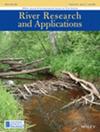上游经验和实验性迁移外来大头鲤鱼提高了大河船闸的上游通过成功率
IF 1.7
4区 环境科学与生态学
Q4 ENVIRONMENTAL SCIENCES
引用次数: 0
摘要
由于人为改造(如水闸和水坝)会影响动物行为,因此研究管制河流中的鱼类活动具有挑战性。例如,密西西比河上游第 19 号水闸(LD19)因水坝无法通过而成为入侵鲤鱼的活动瓶颈。LD19 的上游鱼类通道仅限于闸室,因此是测试入侵鱼类威慑措施的最佳地点,可以限制其进一步扩大范围。评估试验性威慑措施的效果需要了解鱼类活动的基本情况,并对遇到威慑措施的鱼类进行适当的抽样调查,以确保有足够的统计能力。一些证据表明,与没有上游经验的鱼类相比,有过上游经验的鱼类可能会以更高的速度返回上游或挑战潜在的威慑物。为了测试先前的逆流经验会如何提高鱼类逆流通过船闸闸室的速度,我们使用在大坝下方捕获的鳙鱼(下游原生鱼)和在大坝上游捕获的两组鳙鱼(自行游向下游的鳙鱼(上游原生鱼)和在上游捕获并转移到 LD 19 下游的鳙鱼(转移的上游原生鱼))对逆流通过 LD 19 的情况进行了比较。被转移到上游的鲤鱼通过上游的比率最高,在我们的研究中,在 LD 19 下游发现的鲤鱼中有 59% 通过了上游。相比之下,下游原生鲤鱼在两年内没有通过上游。鱼的来源被证明会影响上游通过的成功率。这可能是鱼类通过研究和威慑评估的一个重要考虑因素。本文章由计算机程序翻译,如有差异,请以英文原文为准。
Upstream experience and experimental translocation of invasive bigheaded carps results in increased upstream passage success at a navigation lock in a large river
Fish movements in regulated rivers can be challenging to study because anthropogenic modifications, such as locks and dams, can influence animal behavior. Upper Mississippi River Lock and Dam 19 (LD 19), for example, is an invasive carp movement bottleneck due to an impassable dam. Upstream fish passage at LD19 is restricted to the lock chamber, making it an optimal location to test invasive fish deterrents that could limit further range expansion. Evaluating the effectiveness of experimental deterrents requires baseline knowledge of fish movements and suitable sample sizes of fish encountering the deterrents to ensure adequate statistical power. Some evidence indicates fish with prior upstream experience may return upstream or challenge potential deterrents at a higher rate than fish without such experience. To test how previous upstream experience could increase the rate at which fish moved upstream through a navigation lock chamber, we compared upstream passage through LD 19 using bigheaded carp captured below the dam (downstream-origin) and two groups of bigheaded carp captured upstream from the dam: those that swam downstream on their own volition (upstream-origin fish) and those that were captured upstream and translocated downstream of LD 19 (translocated upstream-origin). Translocated upstream-origin carp demonstrated the highest rate of upstream passage, with 59% of the fish detected downstream from LD 19 passing upstream during our study. In contrast, downstream-origin carp made no upstream passages over 2 years. Fish origin was shown to influence upstream passage success. This may be an important consideration for fish passage studies and deterrent evaluations.
求助全文
通过发布文献求助,成功后即可免费获取论文全文。
去求助
来源期刊

River Research and Applications
环境科学-环境科学
CiteScore
4.60
自引率
9.10%
发文量
158
审稿时长
6 months
期刊介绍:
River Research and Applications , previously published as Regulated Rivers: Research and Management (1987-2001), is an international journal dedicated to the promotion of basic and applied scientific research on rivers. The journal publishes original scientific and technical papers on biological, ecological, geomorphological, hydrological, engineering and geographical aspects related to rivers in both the developed and developing world. Papers showing how basic studies and new science can be of use in applied problems associated with river management, regulation and restoration are encouraged as is interdisciplinary research concerned directly or indirectly with river management problems.
 求助内容:
求助内容: 应助结果提醒方式:
应助结果提醒方式:


